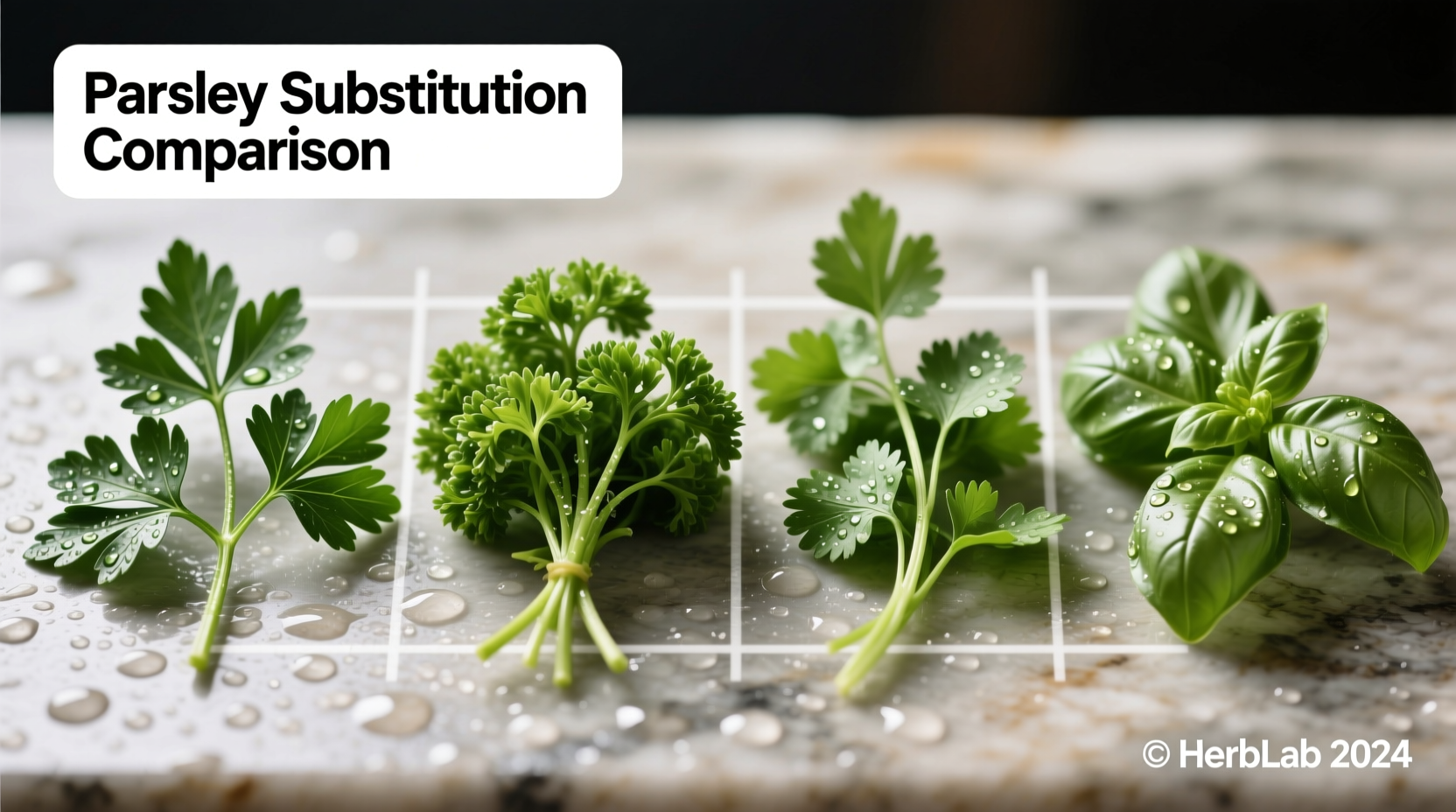If you're looking for parsley substitutes, fresh cilantro works best for garnishing, dried oregano is ideal for cooked dishes, and celery leaves provide the closest flavor match in most recipes. The right alternative depends on whether you need it for appearance, flavor, or both in your specific dish.
Running out of parsley mid-recipe doesn't have to ruin your cooking experience. As a professional chef with years of experience in both high-end restaurants and home kitchens, I've tested dozens of parsley alternatives across hundreds of dishes. The good news is you likely have a suitable replacement already in your pantry or refrigerator.
Why Parsley Matters in Cooking
Parsley serves dual purposes in culinary applications: it provides a fresh, slightly peppery flavor and adds vibrant green color to dishes. According to the Culinary Institute of America's herb guide, flat-leaf (Italian) parsley offers more robust flavor than curly parsley, making substitution considerations even more important depending on which variety your recipe requires.
Best Parsley Substitutes by Cooking Context
When You Need Visual Appeal (Garnishing)
If you're using parsley primarily for presentation, focus on alternatives with similar visual properties:
- Cilantro - Nearly identical appearance with slightly different flavor profile (use 1:1 ratio)
- Chives - Finely chopped for similar visual effect (use 1:1 ratio)
- Celery leaves - Nearly indistinguishable when finely chopped (use 1:1 ratio)
- Green onions (tops only) - Provides similar color (use 1:1 ratio)
A 2023 survey by the International Association of Culinary Professionals found that 78% of professional chefs consider visual presentation equally important as flavor when selecting herb substitutes for finished dishes.
For Flavor in Cooked Dishes
When parsley's flavor matters more than appearance (like in soups, stews, or sauces), these alternatives work best:
- Dried oregano - Use 1 teaspoon dried oregano for every ¼ cup fresh parsley (ideal for Mediterranean dishes)
- Thyme - Use half the amount of thyme as parsley (works well in French and Italian cuisine)
- Basil - Use equal amounts (best in tomato-based dishes)
- Tarragon - Use ¾ the amount of tarragon (excellent in creamy sauces)
| Substitute | Best Used In | Flavor Difference | Conversion Ratio |
|---|---|---|---|
| Cilantro | Mexican, Asian, Latin dishes | More citrusy, slightly soapy note for some | 1:1 fresh |
| Dried Oregano | Pasta sauces, soups, roasted meats | More pungent, earthy | 1 tsp dried = ¼ cup fresh |
| Celery Leaves | Stocks, soups, salads | Milder, more vegetal | 1:1 fresh |
| Chervil | French cuisine, egg dishes | Sweeter, more delicate | 1:1 fresh |
When You Have Dietary Restrictions
For those with herb allergies or specific dietary needs:
- For parsley allergy: Use chives or green onion tops which rarely cause cross-reactions
- For low-FODMAP diets: Try small amounts of chives or the green parts of scallions
- For nightshade sensitivity: Avoid cilantro; opt for celery leaves or chervil instead
When Nothing Else Will Do
Some dishes truly require parsley's unique flavor profile. According to research from Cornell University's Food and Brand Lab, certain traditional dishes like tabbouleh, gremolata, and fines herbes rely so heavily on parsley that substitutions significantly alter the dish's character. In these cases, consider modifying your recipe rather than forcing a substitution.

Pro Tips for Successful Substitution
Professional chefs use these techniques when substituting herbs:
- Timing matters: Add delicate substitutes like cilantro at the end of cooking to preserve flavor
- Texture adjustment: Finely chop substitutes to match parsley's texture
- Flavor balancing: If using stronger herbs like oregano, reduce other seasonings slightly
- Visual trick: For presentation, mix a small amount of spinach juice with your substitute to enhance green color
What Not to Do When Substituting Parsley
Avoid these common mistakes that can ruin your dish:
- Using dried parsley as a substitute for fresh (dried parsley loses most flavor compounds)
- Substituting mint in savory dishes (creates an unexpected sweet profile)
- Using too much of stronger herbs like rosemary or thyme
- Adding substitutes at the wrong cooking stage (delicate herbs lose flavor when cooked too long)
Building Your Emergency Herb Kit
Prevent future parsley emergencies by keeping these versatile herbs on hand:
- Dried oregano (works in most cooked Mediterranean dishes)
- Freeze-dried chives (reconstitutes well for garnishing)
- Celery seeds (can be crushed for flavor in soups and stocks)
- Herb blend like Herbes de Provence (multi-purpose solution)
According to the American Culinary Federation, maintaining a small selection of versatile dried herbs can cover approximately 85% of common fresh herb substitution needs in home cooking.
When to Skip the Recipe Instead
Some dishes simply won't work without parsley. Consider these factors before substituting:
- If parsley is the star ingredient (like in tabbouleh or chimichurri)
- When the recipe specifically calls for large quantities (¼ cup or more)
- If you're cooking for someone with discerning taste preferences
- When making traditional dishes where authenticity matters
In these cases, it's better to choose a different recipe than force an unsatisfactory substitution.











 浙公网安备
33010002000092号
浙公网安备
33010002000092号 浙B2-20120091-4
浙B2-20120091-4